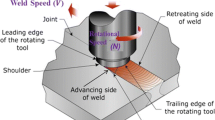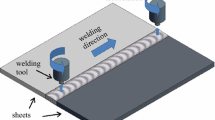Abstract
A simulation study of the Friction Stir Spot Welding process for the lap-joining of thin aluminum sheets was carried out using the FEM code DEFORM 2D. The special feature of the developed FEM model is a 2D approach used for the simulation of a 3D problem, in order to guarantee a very simple and practical solution able to achieve results in a very short time. A set of experiments was performed by means of a CNC machine tool and FSSW lap joints on AA6060-T6 aluminum alloy plates were obtained. The experimental results were used as reference cases for the model validation. A set of tests was carried out by varying the process parameters, namely rotational speed, axial feed rate and plunging depth. Axial welding forces and temperature distribution in the joining region were recorded during the tests and their dependency from the welding parameters was studied. Shear tests were also performed to evaluate the quality of the joints as function of the welding conditions. A satisfactory matching between numerical and experimental data was found (average errors ranging around 10 %), confirming the good predictive ability of the FEM model. The FEM simulations were finally used for the prediction of the joint shear resistance.


















Similar content being viewed by others
References
Thomas WM, Nichola ED, Needam JC, Murch MG, Templesmith P, Dawes CJ, GB Patent Application No. 9125978–8, 1991
Thomas WM, Nichola ED, Needam JC, Murch MG, Templesmith P, Dawes CJ, US Patent Application No. 5460317.P.L., 1995.
Peel M, Steuwer A, Preuss M, Withers PJ (2003) Microstructure, mechanical properties and residual stresses as a function of welding speed in aluminium AA5083 friction stir welds. Proceedings of the 6th International Symposium on Friction Stir Welding, Saint Sauveur, Quebec, Canada
Juan Z, Feng J, Haigen J, Kang W, Long J, Xiaobo C (2010) Comparative investigation of tungsten inert gas and friction stir welding characteristics of Al–Mg–Sc alloy plates. Mater Des 31(1):306–311
Nandan R, DebRoy T, Bhadeshia HKDH (2008) Recent advances in friction stir welding process, weldment structure and properties. Prog Mat Sci 53:980–1023
Sakano R, Murakami K, Yamashita K, Hyoe T, Fuzimoto M, Inuzuka M et al. (2001) Development of spot FSW robot system for automotive body members. Proceedings of the 3rd international symposium of friction stir welding, Kobe, Japan, September 27–28.
Iwashita T, Method and apparatus for joining, US patent No. 6601751 B2, 2003.
Lathabai S, Painter MJ, Cantin GMD, Tyagi VK (2006) Friction spot joining of an extruded Al–Mg–Si alloy. Scripta Mater 55:899–902
Yuana W, Mishraa RS, Webba S, Chenb YL, Carlsonb B, Herlingc DR, Grantc GJ (2011) Effect of tool design and process parameters on properties of Al alloy 6016 friction stir spot welds. J Mater Process Technol 211:972–977
Hirasawaa S, Badarinarayanb H, Okamotoc K, Tomimurad T, Kawanamia T (2010) Analysis of effect of tool geometry on plastic flow during friction stir spot welding using particle method. J Mater Process Technol 210:1455–1463
Fanelli P, Vivio F, Vullo V (2012) Experimental and numerical characterization of friction stir spot welded joints. Eng Fract Mech 81:17–25
Jata KV, Semiatin SL (2000) Continuous dynamic recrystallization during friction stir welding of high strength aluminum alloys. Scr Mater 43:743–749
Arul SG, Miller SF, Kruger GH, Pan TY, Mallick PK, Shih AJ (2008) Experimental study of joint performance in spot friction welding of 6111-T4 aluminum alloy. Sci Technol Weld Join 13:629–637
Freeney T, Sharma SR, Mishra RS (2006) Effect of welding parameters on properties of 5052 Al friction stir spot welds. SAE Technical Series 01–0969
Tozaki Y, Uematsu Y, Tokaji K (2007) Effect of processing parameters on static strength of dissimilar friction stir spot welds between different aluminium alloys. Fatigue Fract Eng Mater 30:143–148
Merzoug M, Mazari M, Berrahal L, Imad A (2010) Parametric studies of the process of friction spot stir welding of aluminium 6060-T5 alloys. Mater. Des. 31/6:3023–3028.
Yin YH, Sun N, North TH, Hu SS (2010) Hook formation and mechanical properties in AZ31 friction stir spot welds. J. Mater. Process. Technol. 210/14:2062–2070.
Bozzi S., Helbert-Etter AL, Baudin T, Klosek V, Kerbiguet JG, Criquid B (2010) Influence of FSSW parameters on fracture mechanisms of 5182 aluminium welds. J. Mater. Process. Technol. 210/11: 1429–1435.
Tozaki Y, Uematsu Y, Tokaji K (2007) Effect of processing parameters on static strength of dissimilar friction stir spot welds between different aluminium alloys. Fatigue Fract Eng Mater 30:143–148
Gerlich A, Su P, Bendzsak GJ, North TH (2005) Numerical modeling of FSW spot welding: preliminary results. Friction Stir Welding and Processing III, TMS
Mandal S, Rice J, Elmustafa AA (2008) Experimental and numerical investigation of the plunge stage in friction stir welding. J Mater Process Technol 203:411–419
Awang M, Mucino VH, Feng Z, David SA (2005) Thermo-mechanical modeling of friction stir spot welding (FSSW) process: use of an explicit adaptive meshing scheme. SAE Int 01:1251
Rajamanickam N, Balusamy V, Madhusudhann RG, Natarajan K (2009) Effect of process parameters on thermal history and mechanical properties of friction stir welds. Mater Des 30(7):2726–2731
Zhang Z, Zhang HW (2008) Numerical studies on controlling of process parameters in friction stir welding. J Mater Process Technol 209:241–270
D’Urso G, Longo M, Giardini C (2013) Friction stir spot welding (FSSW) of aluminum sheets: experimental and simulative analysis. Key Eng Mater 549:477–483
Langerman M, Kvalvik E (2003) Modeling plasticised aluminum flow and temperature fields during friction stir welding. Proceedings of the 6th ASME–JSME Thermal Engineering Joint Conference TED-AJ03-133.
Colegrove PA, Shercliff HR (2004) Modeling the friction stir welding of aerospace alloys. Proceedings of the 5th International FSW Symposium.
Frigaard O, Grong O, Midling OT (2001) A Process Model for Friction Stir Welding of age hardening aluminum alloys. Metallurgical and Materials Transactions A, 32/A:1189–1200.
Author information
Authors and Affiliations
Corresponding author
Rights and permissions
About this article
Cite this article
D’Urso, G., Giardini, C. FEM model for the thermo-mechanical characterization of friction stir spot welded joints. Int J Mater Form 9, 149–160 (2016). https://doi.org/10.1007/s12289-015-1218-y
Received:
Accepted:
Published:
Issue Date:
DOI: https://doi.org/10.1007/s12289-015-1218-y




